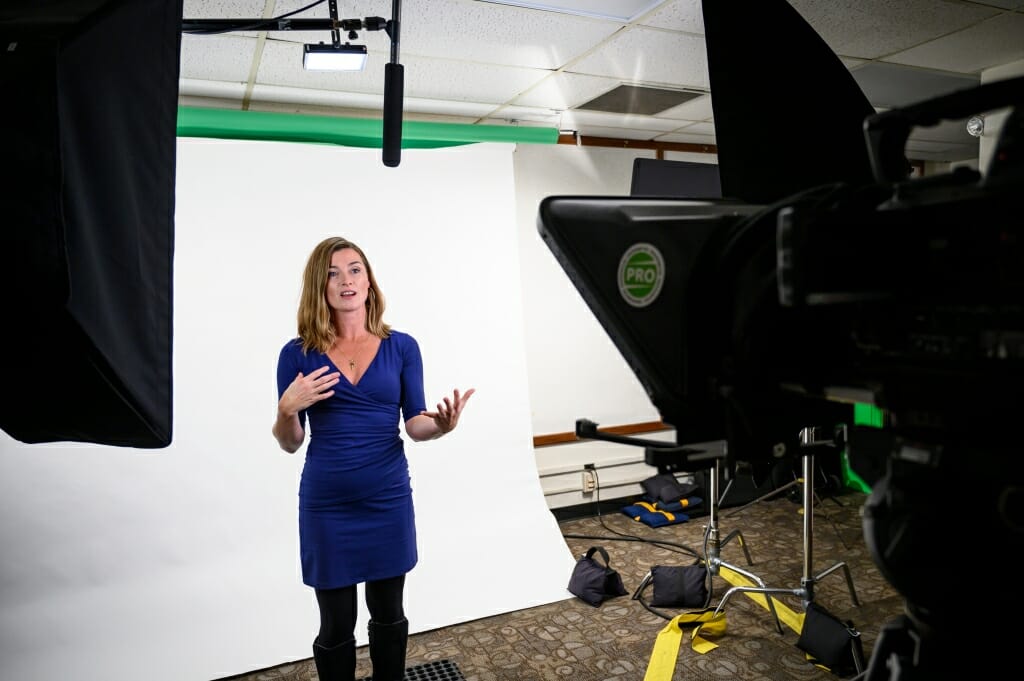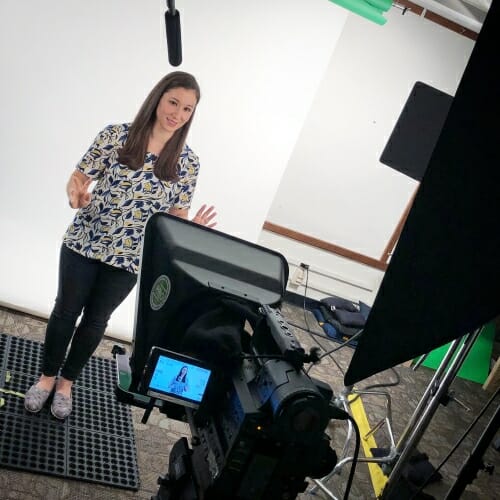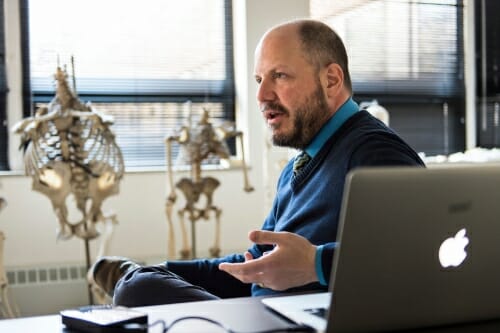Professors prepare carefully to offer alternative education starting March 23
The move from the University of Wisconsin–Madison classrooms where students have gathered to learn for more than 150 years to the high-tech setups in which professors teach students sitting in their homes and apartments around the world is not necessarily an easy one. But Professor of Anthropology John Hawks has a simple message to his fellow professors and instructors: You can do this.
“Do what you do well, carry that into your communication with students online, and be there for them,” says Hawks, who first dipped into remote learning years ago with courses on DVD and, later, through UW–Madison massive open online courses, or MOOCs.
In March 2020, most face-to-face classes at UW–Madison — and at many other U.S. universities — were suspended to help prevent the spread of COVID-19.

“As any teacher knows, making such profound changes is not easy in the short time frame but they are giving it their all,” says Vice Provost Steven Cramer. Photo: Bryce Richter
“In response to COVID-19, our faculty and instructional staff are engaged in an unprecedented shift in how instruction is delivered at UW–Madison,” says Steven M. Cramer, vice provost for teaching and learning. “They are demonstrating their extraordinary commitment to teaching as they prepare instructional changes for the coming weeks with attention and, yes, some unease.
UW–Madison has provided faculty and instructors with tools to prepare to teach their classes using alternative methods, many involving online instruction. Beginning Monday, March 23, UW–Madison courses switched to alternative instruction for the remainder of the semester.
“As any teacher knows, making such profound changes is not easy in the short time frame but they are giving it their all, and will position UW–Madison to fulfill its educational mission during these difficult times,” Cramer says.
Hawks, who is preparing to move both his 450-student anthropology course and his eight-student human evolution seminar online, says instructors have a head start because they’ve already had more than a month of face-to-face instruction with this semester’s students.
“A lot of things we do in online teaching are meant to introduce ourselves to students, but you don’t need that because you’ve been teaching your class for half the semester,” says Hawks. “You’re going to have a successful educational experience because you already have that connection with them.”
Communication Arts Professor Sara McKinnon, who’s provided some training to her fellow instructors about online teaching, says there are many options for teachers looking to develop dynamic, interactive classes online.

Communication Arts Professor Sara McKinnon, who’s provided some training to her fellow instructors about online teaching, says there are many options for teachers looking to develop dynamic, interactive classes online. Photo: Bryce Richter
In her classes, she’s integrated a number of technologies, including Blackboard Collaborate Ultra, which provides students with a real-time, virtual learning environment; Kaltura, a host to stream audiovisual material to students; and Padlet, an online bulletin board that encourages participation with visual cues.
They can be combined with more traditional discussion board platforms that are available on Canvas, the digital course platform used by the university. Content can be delivered with podcast lectures, audio-narrated PowerPoint presentation and multimedia lecture pages that function as “sort of an online textbook.”
McKinnon suggests the modules be relatively consistent, so students know what to expect, with reading assignments and lessons on certain days, and participation and discussion assignments on others.
“Keeping this regular schedule helps students know what to expect so that they can focus more on the details of the task than remembering when something is due,” she says.
Mix audio with visual
In addition, audio should be mixed with visual, McKinnon suggests, so students can track what they hear with a visual cue, which helps retention. That’s why audio-narrated PowerPoint presentations work well, as do podcast lectures with an outline of the lecture available for download.
“Students hear your voice and explanation, but they also see the slide with images and key concepts that you’ve developed to correspond,” she adds.
McKinnon also encourages breaking large materials into shorter clips of 10 minutes maximum, mixed with other items and activities, to keep students engaged rather than checking out while audio plays.

“I am confident that with some practice, both instructors and students can iron out the kinks and still create a productive learning environment,” says Communication Arts Professor Lori Lopez. Photo courtesy of Lori Lopez
Communication Arts Professor Lori Lopez attended a training session that included a practice session where instructors could feel what it was like to be students in the online learning environment for the first time.
“We all struggled a lot, so I can tell there will be a steep learning curve,” Lopez says. “But I am confident that with some practice, both instructors and students can iron out the kinks and still create a productive learning environment.”
Lopez plans to try Blackboard Collaborate Ultra for her small seminar course and for TA-led discussion sections. Her “blended” lecture course with 240 students already offers much content through online videos and lessons, and now she’ll also post the text of the lecture on Canvas.
“Online learning does demand a lot of reflection and self-awareness from students, because they have to be very deliberate about time management and organization in order to be successful,” says Lopez.
While Hawks thinks that online discussion boards and simple videos can work for most classes and instructors, he says to keep in mind those students who learn best in person and need more creative ways to learn remotely.

“Do what you do well, carry that into your communication with students online, and be there for them,” Anthropology Professor John Hawks advises faculty and instructors. Photo: Jeff Miller
“You always have to think of students who need the personal connection. You need to watch out for them and think of ways to give different avenues of education for people who might otherwise be left behind,” says Hawks.
Technology offers many ways to connect
Psychology Professor Jenny Saffran will use Lecture Capture technology to film herself giving each lecture, which includes a PowerPoint presentation on an overhead. The lectures will be closed-captioned by the McBurney Disability Resource Center to accommodate students. She’ll also post her PowerPoint slides online separately so students can refer to them.
She will also offer students the opportunity to virtually meet with her and her course teaching assistants both one-on-one and in small groups via Blackboard Collaborate and Skype, and to participate in group chats through Canvas Chat.
“My goal is to be as available as possible to students to mitigate their stress and anxiety and to help interpret the course material for them,” Saffran says. A well-designed online course is a wonderful thing, she adds, but it’s more difficult to transition in-person courses to online formats.

“My goal is to be as available as possible to students to mitigate their stress and anxiety and to help interpret the course material for them,” Psychology Professor Jenny Saffran says. Photo: Jeff Miller
“I’m lucky because I’ve taught this class many times, so I know which topics and concepts tend to be especially tricky, and will provide extra resources as needed,” Saffran says. “For myself, I’m trying to manage expectations, both my own and my students’. I am cutting my students slack wherever I can and I hope that they do the same for me.”
Figuring it out together
With this, McKinnon agrees. “A spirit of ‘we are all figuring this out together’ goes a long way as students adapt to new technologies and learning platforms,” she says.
In the beginning, students may sometimes miss deadlines, and struggle to find materials, Lopez notes. “So I think the key here will be patience in realizing that remote learning can totally work, but maybe not right away. We all need to be understanding about helping our students (and ourselves) adjust to this new style of teaching and learning.”
Lopez encourages instructors to look at the learning objectives they want to achieve in the next few weeks and pare them down to only the essentials.
“Student attention is going to be divided as they adapt to both new learning environments and personal situations, and we should reconsider what can realistically be accomplished,” she says. “No online course looks exactly like an in-person course, and prioritizing the most essential learning objectives is one way to clear a path forward for both instructors and students.”
For those instructors who want to get creative, Hawks suggests considering what remote teaching can uniquely offer.
“You’re taking something away, but with technology and the facilities that you have, you can give them something you can’t give them in the classroom,” says Hawks, who has taken his virtual classrooms to archaeological sites in the past — something that can’t happen in the lecture hall.
Bryce Richter and Eric Hamilton contributed to this story.



